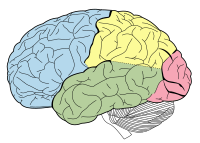
Photo from wikipedia
Inhibitory control enables humans to stop prepotent motor activity, and is commonly studied using go/no-go or stop-signal tasks. In stop-signal tasks, prepotent motor activity is elicited by delaying stop signals… Click to show full abstract
Inhibitory control enables humans to stop prepotent motor activity, and is commonly studied using go/no-go or stop-signal tasks. In stop-signal tasks, prepotent motor activity is elicited by delaying stop signals relative to go signals. In go/no-go tasks, however, trials include only one signal-go or no-go. Hence, prepotent motor activity has to be ensured differently-for example, by using rare no-go trials and short trial durations. However, a literature survey shows that ∼40% of studies use equiprobable go/no-go trials and ∼20% use long stimulus-stimulus intervals (> 4 s). It is unclear whether such slow-paced, equiprobable go/no-go tasks elicit prepotent motor activity and probe inhibitory control. We recorded EEG during four go/no-go tasks, varying in no-go probability and trial duration. We quantified prepotent motor activity on successfully inhibited no-go trials using the lateralized readiness potential. Only fast-paced go/no-go tasks with rare no-go trials reliably evoked such activity. We then used a stop-signal task and independent component analysis to isolate an established neural signature of inhibitory control, and investigated this signature's activity across the go/no-go tasks. Across tasks, increased prepotent motor activity on individual no-go trials was accompanied by greater frontocentral P3 amplitudes, confirming it as an index of inhibition. Crucially, this inhibition-related activity showed a 75% reduction in slow-paced, equiprobable go/no-go tasks compared to fast-paced, rare no-go versions. Therefore, since many common go/no-go task configurations do not reliably evoke prepotent motor activity, their inhibitory requirements are greatly reduced. This has major implications for the usage of go/no-go tasks in psychological experiments.
Journal Title: Psychophysiology
Year Published: 2018
Link to full text (if available)
Share on Social Media: Sign Up to like & get
recommendations!